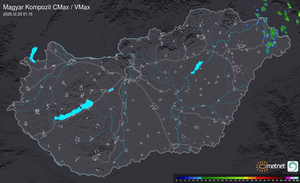Globális jelenségek
El Nino Officially Declared for 2015
The climate pattern is here but weak
March 5, 2015 |By Andrea Thompson and Climate Central | Véalo en español
In part because of its weakness, as well as its unusual timing, the El Niño isn’t expected to have much impact on U.S. weather patterns.
Credit: NOAA
Just when everyone had pretty much written it off, the El Niño event that has been nearly a year in the offing finally emerged in February and could last through the spring and summer, the National Oceanic and Atmospheric Administration announced Thursday.
This isn’t the blockbuster, 1998 repeat El Niño many anticipated when the first hints of an impending event emerged about a year ago. This El Niño has just crept across the official threshold, so it won’t be a strong event.
“We’re basically declaring El Niño,” NOAA forecaster Michelle L’Heureux said. “It’s unfortunate we can’t declare a weak El Niño.”
In part because of its weakness, as well as its unusual timing, the El Niño isn’t expected to have much impact on U.S. weather patterns, nor bring much relief for drought-stricken California.
Link
But forecasters say it could nudge weather patterns in other areas of the globe, especially if it persists or intensifies, and could boost global temperatures—following a 2014 that was already the hottest year on record.
“It does tilt the odds toward warmth,” L’Heureux said.
Link
Spring and summer
This late winter emergence of the El Niño means that the hallmark U.S. impacts—wet and cool conditions across the southern U.S.—won’t happen.
“Over us [the impact] becomes very, very muted” in spring, L’Heureux said.
Forecasters believe the current Kelvin wave and the already warmer ocean temperatures, signal that the El Niño is going to persist, which was another factor in officially declaring an event.
The CPC forecasts a 50 to 60 percent chance that the El Niño will chug along through the spring and summer. If it does, it could tamp down the Atlantic hurricane season and juice the season in the eastern Pacific, as many said it did last summer, before the El Niño was official.
That official designation has already spurred much debate in the climate community, since the ocean was warm enough through much of 2014 to qualify as an El Niño.
“I’m sure it’s going to be discussed quite a bit,” L’Heureux said.
But whether or not those warm oceans meant an El Niño was in place, they, along with warm waters in other ocean basins, helped elevate global surface temperatures in 2014, leading to the warmest year on record.
The climate pattern is here but weak
March 5, 2015 |By Andrea Thompson and Climate Central | Véalo en español
In part because of its weakness, as well as its unusual timing, the El Niño isn’t expected to have much impact on U.S. weather patterns.
Credit: NOAA
Just when everyone had pretty much written it off, the El Niño event that has been nearly a year in the offing finally emerged in February and could last through the spring and summer, the National Oceanic and Atmospheric Administration announced Thursday.
This isn’t the blockbuster, 1998 repeat El Niño many anticipated when the first hints of an impending event emerged about a year ago. This El Niño has just crept across the official threshold, so it won’t be a strong event.
“We’re basically declaring El Niño,” NOAA forecaster Michelle L’Heureux said. “It’s unfortunate we can’t declare a weak El Niño.”
In part because of its weakness, as well as its unusual timing, the El Niño isn’t expected to have much impact on U.S. weather patterns, nor bring much relief for drought-stricken California.
Link
But forecasters say it could nudge weather patterns in other areas of the globe, especially if it persists or intensifies, and could boost global temperatures—following a 2014 that was already the hottest year on record.
“It does tilt the odds toward warmth,” L’Heureux said.
Link
Spring and summer
This late winter emergence of the El Niño means that the hallmark U.S. impacts—wet and cool conditions across the southern U.S.—won’t happen.
“Over us [the impact] becomes very, very muted” in spring, L’Heureux said.
Forecasters believe the current Kelvin wave and the already warmer ocean temperatures, signal that the El Niño is going to persist, which was another factor in officially declaring an event.
The CPC forecasts a 50 to 60 percent chance that the El Niño will chug along through the spring and summer. If it does, it could tamp down the Atlantic hurricane season and juice the season in the eastern Pacific, as many said it did last summer, before the El Niño was official.
That official designation has already spurred much debate in the climate community, since the ocean was warm enough through much of 2014 to qualify as an El Niño.
“I’m sure it’s going to be discussed quite a bit,” L’Heureux said.
But whether or not those warm oceans meant an El Niño was in place, they, along with warm waters in other ocean basins, helped elevate global surface temperatures in 2014, leading to the warmest year on record.



